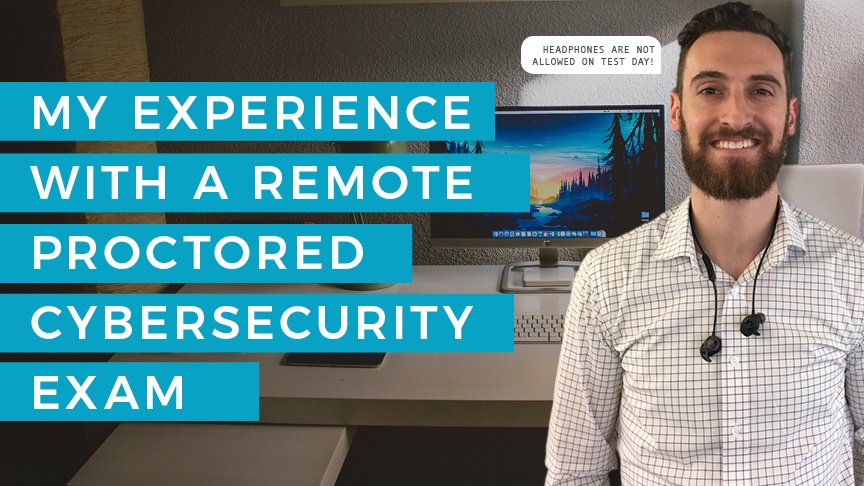Test-takin’ is a-changin’
I remember my first cert exam. Sporting my lucky sweatpants, I drove 40 minutes to the closest testing center to enter a beige, over-air conditioned, over-crowded computer lab that smelled like the inside of an old gym bag.
Fast forward a few years and cybersecurity cert exams later. I am sitting in my apartment, at my desk, still in my lucky sweatpants, taking a remotely-proctored exam. While the sweatpants remained the same, my first and most recent exam experiences were dramatically different. It’s an experience that will likely affect many test-takers very soon, such as CEH (Certified Ethical Hacker) hopefuls.
The Set Up
The exam was administered by a third-party remote proctoring service. My proctor and I met virtually on a remote meeting technology that required me to download and install software. To all our security-conscious readers, brace yourself: The proctor remotely accessed my computer to close unnecessary browsers, applications, and disable screen-grabbing capabilities. He flipped on my internal webcam to reveal my shocked, cringing face watching my mouse move by someone else’s decree.
He then instructed me to rotate my computer camera 360 degrees so he could see the physical surroundings in my apartment. I assume he was looking for hidden monitors, cell phones, note cards, earbuds, or anything else that would give me an unfair advantage.
Clean Desk Testing Policy
Things weren’t up to his satisfaction. I had a suspicious-looking stack of bills and flyers on the kitchen counter behind me. I was asked to file away the papers lest the takeout menu tell me the port number for LDAP.
I am still pondering why it was necessary to move papers behind me because I then learned an important rule of remote test-taking: No moving from your chair.
“What about getting up to stretch?” I asked. Nope.
“What about standing up but keeping the chair attached to my bottom?” Nope.
“What if I had to use the bathroom at some point during my five hour exam?” Sorry.
My review of Business Continuity and Disaster Recovery taught me to prepare for the worst. Before the exam started, I grabbed a bottle, bucket, and toilet paper. I felt like a competitive biker who relieves themselves on the move to maintain their pace. If you’re wondering, the mobile bathroom was never used.
The Exam
The exam began and there were two other wrinkles unique to remote proctoring that I had to work through:
1. I wasn’t allowed to have access to a pen and paper
2. I couldn’t talk out loud (even at a low volume)
These had been two personal staples of test taking strategies learned through CyberVista test day strategies. The Grid method is a way to eliminate answer choices with pen and paper since you can’t scratch out answer choices on a computer.
The Grid method also serves as a record keeper. If you need to come back and revisit a question, the grid will have a record of answer choices that you have already eliminated. It saves time and brain power; your second pass through the question, you are now choosing between, ideally, two answer choices instead of four. You’ve doubled your chances of getting the question correct. Up to 50% from 25%.
Even though I didn’t have access to a physical grid method, I still relied on the strategy of eliminating at least two incorrect answer choices before selecting my answer choice.
The next challenge of not being able to talk out loud requires a bit of context. Cybersecurity certification exams are not just technical exams. They are reading comprehension exams. Sometimes questions are poorly worded, on purpose, to test your ability to think like the test maker.
A strategy to help with this phenomenon is to reword the question in your own words. That makes the question more approachable, simpler, and less intimidating. I reword questions out loud. I talk through it with myself. Forcing myself to put the content into a coherent sentence makes the question easier to understand. My remote proctor didn’t appreciate my gibbering.
Talking during the exam was not allowed in case I was transmitting information about the test questions to my next door neighbor. I, again, didn’t abandon my test day strategy. I just did the rewording internally. And a few mumbles even flew under the radar.
The Experience
Overall, my first experience with remote proctoring was mixed with both positives and negatives. I enjoyed the convenience of taking an exam at home. It gave me faster access to the champagne after I passed. But was it worth sacrificing my privacy and machine access for? That’s a convenience versus privacy debate that’s harder than any certification exam question.
Gearing up for a remote proctored exam? Check out our remote testing-specific test day strategies in our comprehensive certification training courses.

